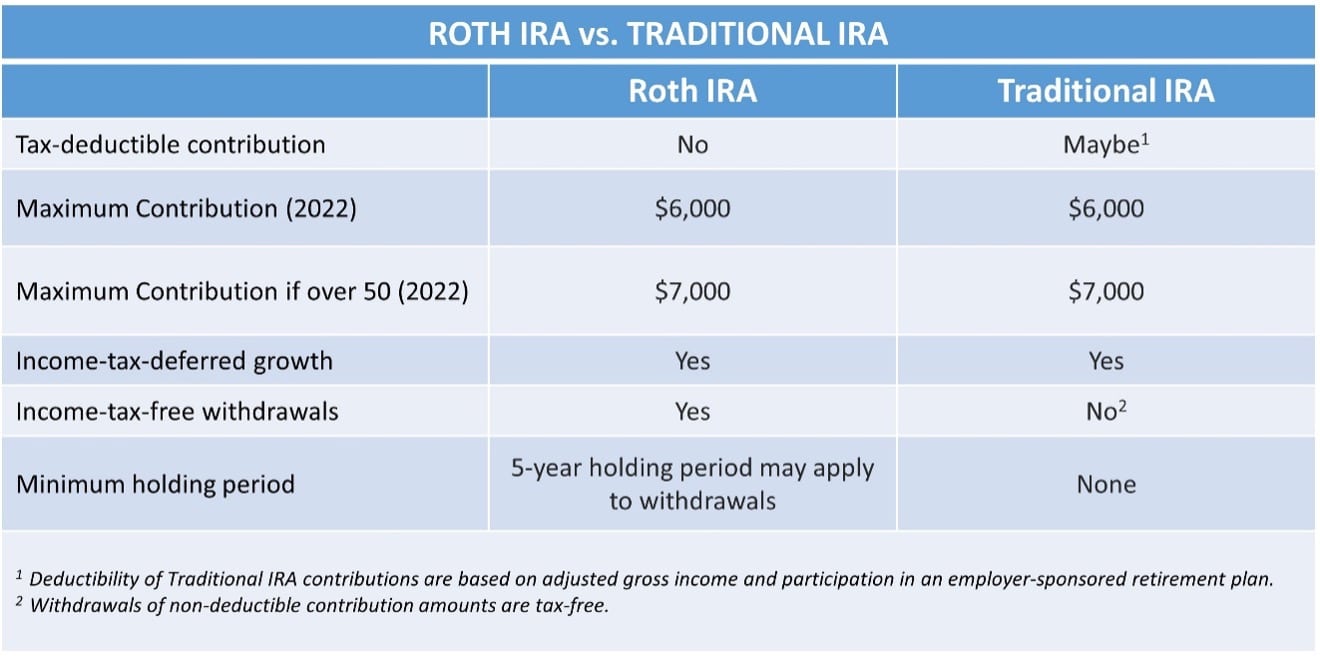In May 2022, after several months of volatility across all financial markets, the S&P 500 had fallen into the second bear market in two years. Far from being a reason to worry, an ordinary market pullback or correction serves as a good time for investors to adjust their investing strategies and tax minimization tactics. One way to do that is to look at Roth IRAs.
Roth IRA Basics
Roth IRAs are accounts that allow for tax-free accumulation and distribution. Unlike Traditional IRAs, Roths do not offer a tax deduction on contributions. Because tax diversification in a retirement income plan is an important part of strategizing, it is often best to have both Roth IRAs and Traditional IRAs within a pre-retiree’s portfolio.
Another difference between the Roth and Traditional IRA is that the Roth has no required minimum distributions (RMD). With a Traditional IRA, the IRS requires account holders aged 721/2 or older to make an annual RMD based on their life expectancy. The Roth has no such requirements.
Without an RMD, Roth IRAs grant more freedom to decide how to take income in retirement. Because qualified Roth distributions are not included in the account holder’s gross income, those who pull income from different sources, such as real estate, 401(k)s, and Traditional IRAs, can get additional income from their Roth without increasing their tax liabilities.
Maximum IRA contributions in 2022 are the same for both types of accounts, with $6,000 the cumulative maximum for anyone under 50. Those who are 50 and older can contribute up to $7,000. The chart below illustrates the primary differences between Roth and Traditional IRAs.

The IRS sets income limits that restrict high earners. The limits are based on the taxpayer’s modified adjusted gross income (MAGI) and tax-filing status. In 2022, single taxpayers will be able to make full Roth IRA contributions as long as they make less than $129,000 and partial contributions up to the maximum MAGI of $144,000. For married couples filing together, the limits will be $204,000 and $214,000, respectively. There is a strategy we discuss called the “backdoor Roth IRA” for higher income earners who exceed these limits.
Converting to Roth
As noted in the other articles authored by OJM team members, a Roth IRA conversion is one of several financial actions that investors can take in uncertain times. A Roth IRA conversion involves the transfer of retirement assets from a traditional, simplified employee pension (SEP), or SIMPLE IRA, or from a defined-contribution plan such as a 401(k), to a Roth IRA. While the account owner has to pay income tax on the money they convert to the extent it has not previously been taxed, they will be eligible to make tax-free withdrawals from the account in the future.
During a downturn, assets fall in price, allowing for their conversion to Roth at a reduced value. They then grow tax-free when the market recovers. For example, in May of 2022, Disney stock was down about 30% year-to-date. An IRA with $100,000 in Disney stock at the start of 2022 might have fallen as low as $70,000 in May. If the IRA holder and their advisor felt comfortable with the stock’s long-term potential to bounce back, and decided to hold the stock and convert to a Roth, the account holder would pay a marginal tax on the converted $70,000 stock. After the conversion, the IRA holder has the opportunity to enjoy tax-free growth in the Roth IRA if the stock regains value.
When the market falls, an investor’s tax bill on a converted IRA can be reduced. However, it is important to remember that, when doing conversion distributions within the first five-year qualifying period from a Roth IRA, they may be subject to a 10% early distribution penalty.
There are no guarantees, but if you feel good about a particular holding or fund, converting your stocks to a Roth IRA may be an excellent opportunity to grow your money. As we deal with market volatility throughout 2022, your advisor should help you think of ways to enhance your overall financial plan, your tax strategies, and your retirement income plan for the future.

